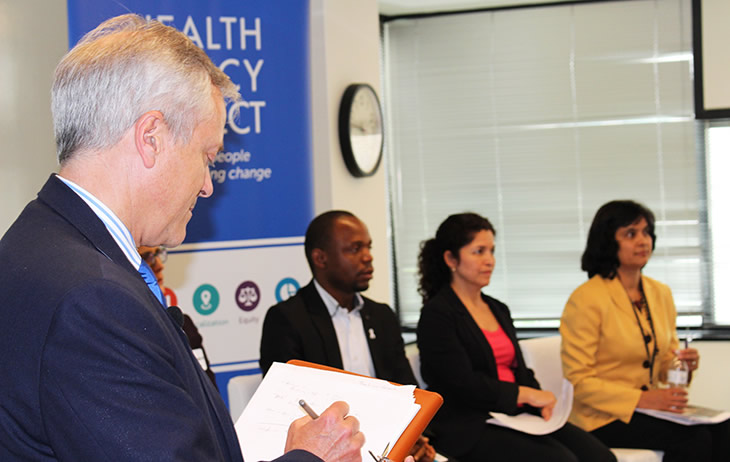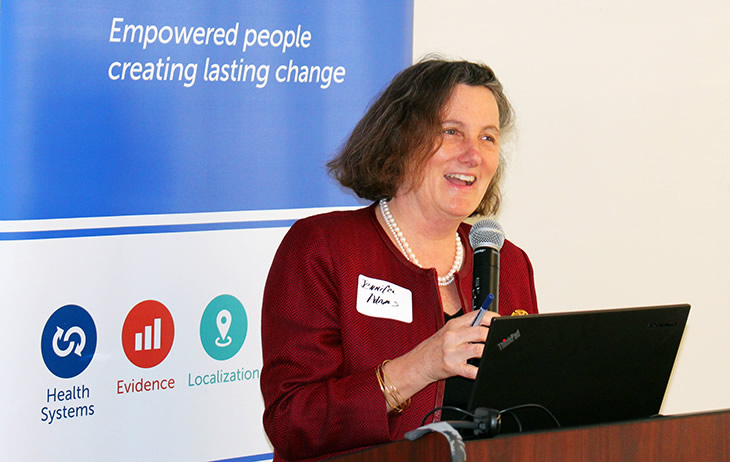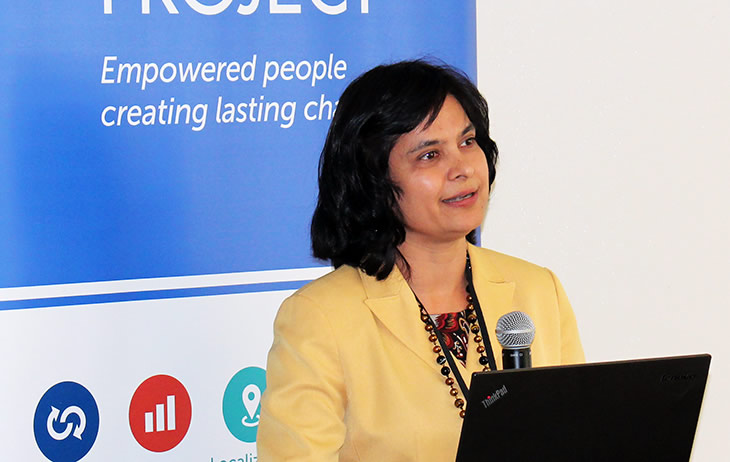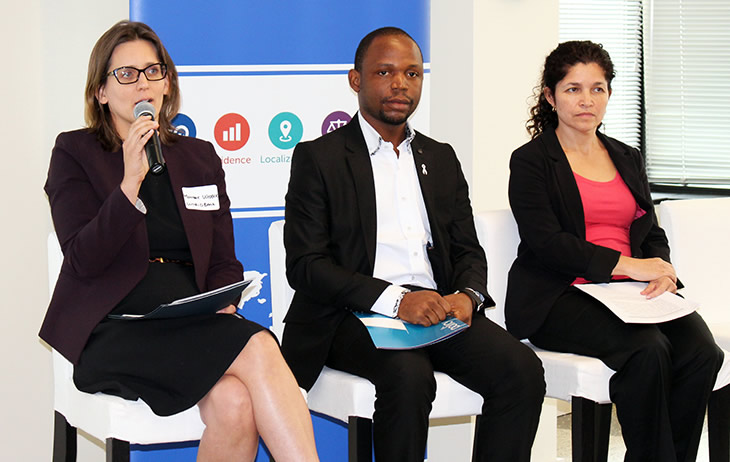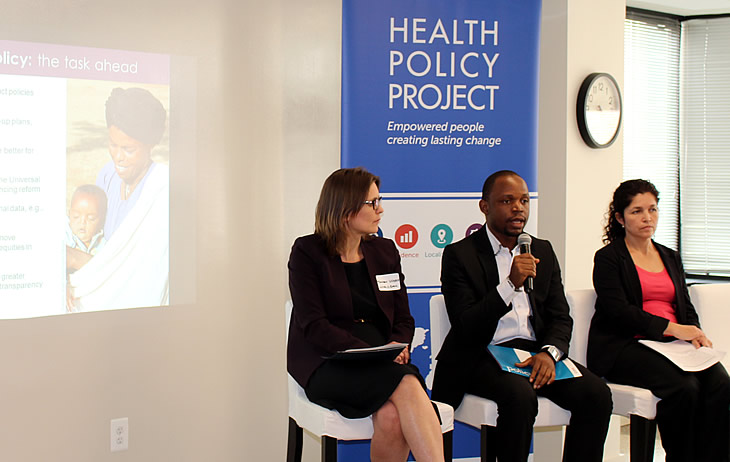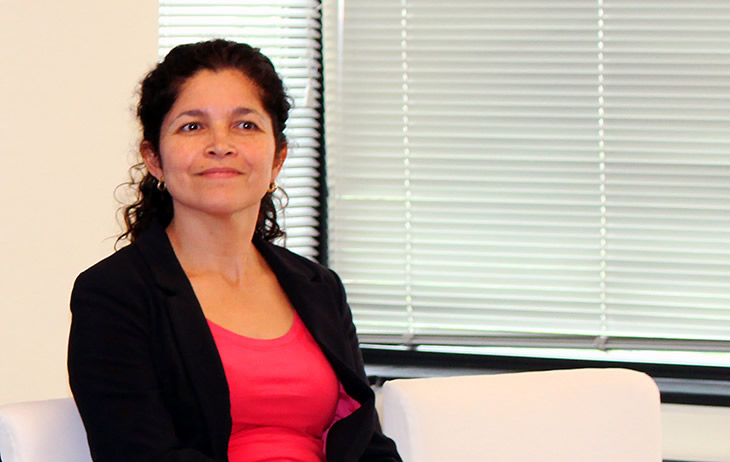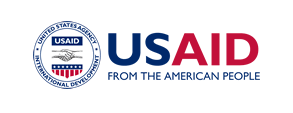The Health Policy Project ended in 2016. Work continued under Health Policy Plus (HP+) until 2022.
NEWS & VIEWS
May 12, 2015
WASHINGTON, DC—The U.S. Agency for International Development (USAID) has pledged to end preventable maternal mortality by 2035. On May 7, the USAID-funded Health Policy Project (HPP) held a forum titled “Making the Case for Mothers: Improving Lives through Policy” to explore the central roles of global leadership, local partnerships, financing, and evidence-informed policy and advocacy in achieving this ambitious goal. More than 100 members of the international development community, policymakers, and representatives of think tanks and donor organizations attended the session at HPP’s Futures Group headquarters or participated online.
Moderated by Jeff Jordan, president and CEO of the Population Reference Bureau, this event was one of a series designed as an opportunity for HPP and others—USAID, in-country partners, and implementers—to share their knowledge with the global health community.
Jennifer Adams, who gave the forum’s keynote address, is USAID’s deputy assistant administrator in the Bureau for Global Health. She described this period—as the United Nations’ Millennium Development Goals (MDGs) give way to the post-2015 development agenda—as “a moment for reflection.” The MDGs made significant progress, she said, but there’s a lot of unfinished business, which will require money. In particular, maternal and child health has been chronically underfunded; the Global Financing Facility (GFF) in Support of Every Woman Every Child, which USAID and others have joined to create, will help to turn that around. USAID’s financial commitment to the GFF is part of its larger “maternal health vision for action,” which focuses on enabling and mobilizing individuals and communities; advancing high-quality, respectful care; and strengthening health systems. Ms. Adams said policy is an important means for holding governments accountable for their actions and inaction.
Suneeta Sharma, HPP’s director, discussed the importance of inclusive, rights-based, evidence-informed policies as the foundation of development work. She gave examples from Kenya, Guatemala, and Tanzania of HPP’s comprehensive approach, which doesn’t stop with policies but also tackles all aspects of operationalizing them: advocacy; anticipating and removing barriers to implementation and access; costing and prioritizing investments; monitoring and evaluating results; and engaging with national and subnational governments to sustain budgetary commitment over the long term.
Monique Vledder, M.D., manager of the Health Results Innovation Trust Fund and GFF Coordinator at World Bank, said the GFF’s business plan is results-focused and emphasizes “smart, scaled, and sustainable financing for reproductive, maternal, newborn, child, and adolescent health (RMNCAH).” To ensure sustainability, she said, mobilization of domestic resources is an eligibility requirement for GFF support. “It’s exciting to see that we’re talking about ending preventable maternal and child deaths in this generation,” Dr. Vledder said. “The GFF makes it possible for RMNCAH programs to be truly financed on a national scale.”
Tonte Ibraye, national coordinator of the White Ribbon Alliance (WRA)/Nigeria and Marlyn Marín, planning, monitoring, and evaluation manager for the Health and Education Policy Project (HEPP, which is part of HPP), in Guatemala, discussed the importance of civil society engagement in their countries. In Nigeria, advocates mobilized by the WRA persuaded the government to adopt a respectful maternity care policy, based on the WRA’s charter of the universal rights of childbearing women. In Guatemala, HEPP supported campaigns by civil society organizations representing both women and men that led to passage of the Healthy Motherhood law, which raises motherhood to the national stage, focusing attention on the most vulnerable women: rural, indigenous, and poor. The law extends to all healthcare institutions and civil society organizations and mandates universal high-quality maternal and neonatal services. One result of the law is the addition of special spaces in health facilities to accommodate vertical delivery (a traditional practice).
These examples, according to Ms. Sharma, demonstrate the crucial role that civil society partners have in all phases of the health policy process.
A comment by Ms. Adams serves as a concise and eloquent summary of the discussion: “We know what we need to do. Now is the time to match rhetoric with policy and budget to make maternal and child health goals a reality.”
Additional Resources
- Watch the GoToWebinar recording of our related event, "Family Planning Advocacy—The Power of Quick Wins." (An accessible version of this presentation is being compiled for our YouTube channel.)
- See Making the Case for Mothers: Improving Lives Through Policy for HPP’s perspectives on how USAID investments in health policy, governance, finance, and advocacy contribute to ending preventable maternal mortality landscape.
- Learn more about all of HPP's work in maternal health.
What's New
- Something to Build On: “Innovation Exchange” Celebrates the Health Policy Project’s Close and a New Beginning
- What Will it Take for Tanzania to Achieve ART Targets and Ensure Long-Term Sustainability of the HIV Response?
- Helping Kenya’s County Leaders Advocate for Increased Health Investments
- HPP Holds Working Meeting on Ensuring Responsible PEPFAR Transitions for Key Populations
- Health Policy Project Celebrates 2016 International Women's Day
- HPP Staff Participate in White House Conference on HIV Stigma Reduction



